Labyrinth › Hammurabi » Origins and History
Articles and Definitions › Contents
- Labyrinth › Ancient History
- Hammurabi › Who Was
Ancient civilizations › Historical places, and their characters
Labyrinth › Ancient History
Definition and Origins
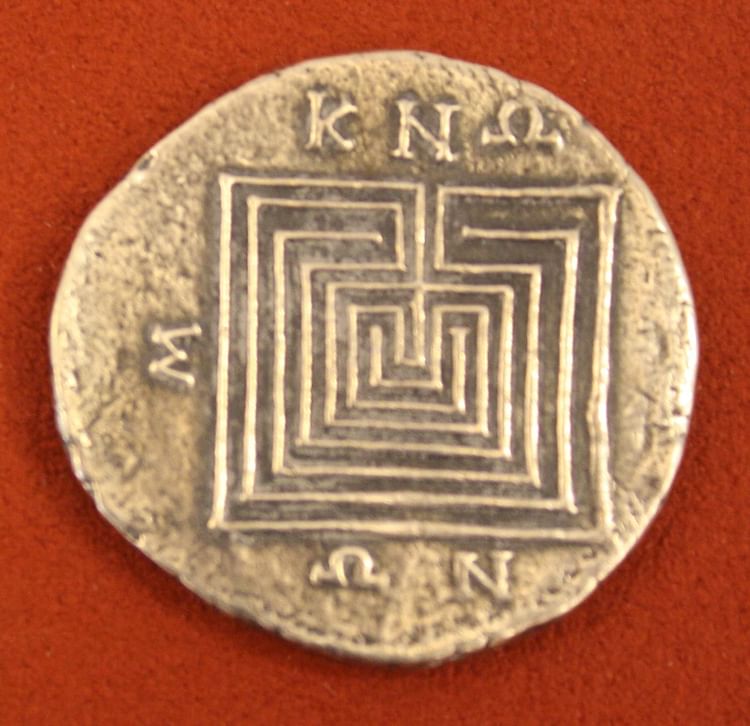
The word labyrinth comes from the Greek labyrinthos and describes any maze-like structure with a single path through it which differentiates it from an actual maze which may have multiple paths intricately linked. Etymologically the word is linked to the Minoan labrys or 'double axe', the symbol of the Minoan mother goddess of Crete, although the actual word is Lydian in origin and most likely came to Crete from Anatolia ( Asia Minor ) through trade.
Labyrinths and labyrinthine symbols have been dated to the Neolithic Age in regions as diverse as modern-day Turkey, Ireland, Greece, and India among others. In the Tantric texts of India, the labyrinth is often featured in the design of mandalas while in Britain and Ireland they are pre-figured in the ring-and-cup marks often found in stone work and the famous swirl designs found at sites such as Newgrange.
The labyrinth has been defined as distinct from the maze in that, as noted above, a labyrinth typically has a single path which winds through it while a maze can have many. Even so, the terms labyrinth and maze are often used interchangeably. The scholars Alwyn and Brinley Rees discuss the significance of the labyrinth-maze and why the design seems to have resonated so strongly with ancient people, specifically the Celts :
Much has been written during the past three decades about the ritual significance of mazes, both as a protection against supernatural powers and as a path which the dead must follow on their way to the world of the spirits.Here we will simply note that mazes are in relation to directions what betwixts-and-betweens are in relation to opposites. In passing through a maze one is not going in any particular direction, and by so doing one reaches a destination which cannot be located by reference to the points of the compass. According to Irish folk-belief, fairies and other supernatural beings can cause a man to lose his bearings…it is when the voyagers have lost their course and shipped their oars – when they are not going anywhere – that they arrive in the wondrous isles.(346)
The labyrinth/maze, then, may have served to help one find their spiritual path by purposefully removing one from the common understanding of linear time and direction between two points. As one traveled through the labyrinth, one would become increasingly lost in reference to the world outside and, possibly, would unexpectedly discover one's true path in life. The theme of the labyrinth leading to one's destiny is most clearly illustrated in one of the best-known stories from Greek mythology : Theseus and the Minotaur.
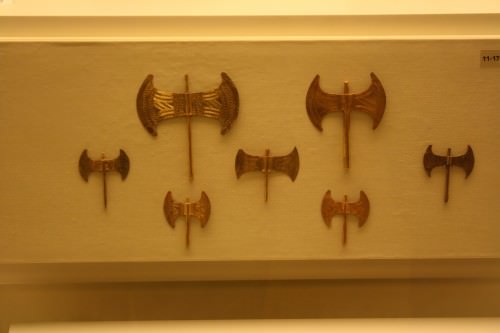
Minoan Double Axes
THE LABYRINTH OF CRETE
The most famous labyrinth is found in Greek mythology in the story of Theseus, prince of Athens. This labyrinth was designed by Daedalus for King Minos of Knossos on Crete to contain the ferocious half-man/half-bull known as the Minotaur.When Minos was vying with his brothers for kingship, he prayed to Poseidon to send him a snow-white bull as a sign of the god's blessing on his cause. Minos was supposed to sacrifice the bull to Poseidon but, enchanted by its beauty, decided to keep it and sacrifice one of his own bulls of far less quality. Poseidon, enraged by this ingratitude, caused Minos' wife Pasiphae to fall in love with the bull and mate with it. The creature she gave birth to was the Minotaur which fed on human flesh and could not be controlled. Minos then had the architect Daedalus create a labyrinth which would hold the monster.
SEVEN YOUNG ATHENIAN MEN & MAIDENS WERE SENT TO CRETE EVERY YEAR & THEN RELEASED INTO THE LABYRINTH TO BE EATEN BY THE MINOTAUR.
Since Minos was hardly interested in feeding his own people to the creature, he taxed the city of Athens with tribute which included sending seven young men and maidens to Crete every year who were then released into the labyrinth and eaten by the Minotaur. Daedalus' labyrinth was so complex that he, himself, could barely navigate it and, having successfully done so, Minos imprisoned him and his son, Icarus, in a high tower to prevent him from ever revealing the secret of the structure. Later, in another famous tale from Greek mythology, Daedalus and Icarus escape their prison using the feathers of birds bound together by wax to form wings with which they fly from the tower. Icarus flew too close to the sun, melting the wax of his wings, and fell into the sea where he drowned.
Prior to their flight, however, Athens was annually sending the 14 young people to Crete to be killed in the labyrinth until Theseus, son of King Aegeus, vowed to put an end to his people's suffering. He volunteered as one of the tributes and left Athens in the ship with the traditional black sails hoisted in mourning for the victims. He told his father that, should he be successful, he would change the sails to white on the trip home.
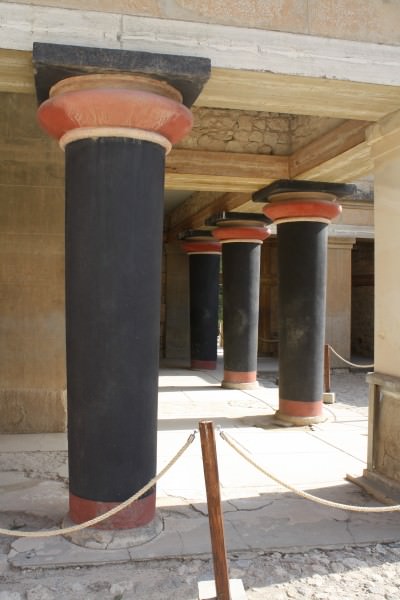
Labyrinth of Knossos
Once on Crete, Theseus attracted the attention of Minos' daughter Ariadne who fell in love with him and secretly gave him a sword and a ball of twine. She told him to attach the thread to the opening of the labyrinth as soon as he was inside and, after he had killed the Minotaur, he would then be able to follow it back to freedom. Theseus kills the monster, saves the youths who were sent with him, and escapes from Crete with Ariadne but abandons her on the island of Naxos on his way home. In his haste to reach Athens afterwards, he forgets to change the sails on the tribute ship from black to white and Aegeus, seeing the black sails returning, flings himself into the sea and dies; Theseus then succeeds him.
THE LABYRINTH AS SYMBOL OF CHANGE
Aside from its purpose as an origin myth – in that the Aegean Sea comes to be so-named for King Aegeus after his death – the story focuses on the coming-of-age of the prince Theseus and how he ascends to the throne. Theseus is the great hero who rescues his companions and delivers his city from the curse of the Minotaur but he is also deeply flawed in that he betrays the woman responsible for his success willingly and, unwittingly, causes the death of his father by forgetting to change the color of the sails.
THE LABYRINTH IN THE STORY SERVES AS THE VEHICLE FOR THESEUS' TRANSFORMATION FROM A YOUTH TO A KING.
The labyrinth in the story serves as the vehicle for Theseus' transformation from a youth to a king. He must enter a maze no one knows how to navigate, slay a monster, and return to the world he knows; he accomplishes this but still retains his youthful flaws until he is changed by the loss of his father and must grow up and assume adult responsibility. The labyrinth presented him with the opportunity to change and grow but, like many people, Theseus resisted that opportunity until change was forced upon him.
The archaeologist Arthur Evans (1851-1941 CE) uncovered what he believed to be the labyrinth at Knossos in his excavations between 1900-1905 CE. Although this claim has been challenged, the fabled labyrinth is still associated with the site of Minos' palace at Knossos and ancient writers reference it as an actual site, not a mythological construct. Evans was certain of his find and explained the mythological aspect of the Minotaur through the Minoan sport of bull jumping (shown in frescoes on the walls of the palace) in which, by grabbing the bull's horns and leaping back over the animal, man and bull appeared to be one creature.
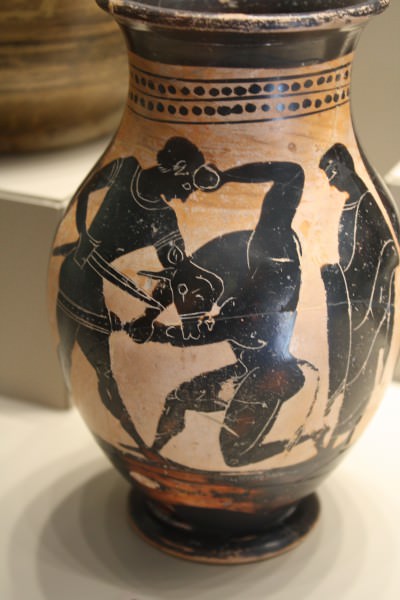
Theseus & the Minotaur
Whether there was a literal labyrinth at Knossos, however, is not as important as the meaning of the labyrinth in the story as a symbol of change and transformation. This same type of symbolism is also seen elsewhere and, notably, in the most famous labyrinth of antiquity: that of Amenemhet III (c. 1860-1815 BCE) of Egypt.
THE LABYRINTH AT HAWARA
The labyrinth at Hawara was so impressive that, according to Herodotus, it rivaled any of the wonders of the ancient world.Scholar Miroslav Verner notes that Amenemhet III's labyrinthine complex was “mentioned by ancient travelers” and continues:
Herodotus, Diodorus Siculus, Strabo, and Pliny all refer to it. According to Diodorus, Daedalus was so impressed by this monument during his journey through Egypt that he decided to build a labyrinth for Minos in Crete on the same model. (430)
The labyrinth was an Egyptian temple precinct of a pyramid complex comprising multiple courts built at Hawara by Amenemhet III of the 12th Dynasty during the period of the Middle Kingdom (2040-1782 BCE). This labyrinth was a mortuary complex grander and more intricate than any other constructed up to that time. The monumental structure is described by Herodotus:
I saw it myself and it is indeed a wonder past words… It has twelve roofed courts with doors facing one another, six to the north and six to the south and in a continuous line. There are double sets of chambers in it, some underground and some above, and their number is 3,000…The passages through the rooms and the winding goings-in and out through the courts, in their extreme complication, caused us countless marvelings as we went through, from the court into the rooms, and from the rooms into the pillared corridors, and then from these corridors into other rooms again, and from the rooms into other courts afterwards. The roof of the whole is stone, as the walls are, and the walls are full of engraved figures, and each court is set round with pillars of white stone, very exactly fitted. At the corner where the labyrinth ends there is, nearby, a pyramid 240 feet high and engraved with great animals. The road to this is made underground. ( Histories, II.148)
Strabo describes the labyrinth as “a great palace composed of many palaces” and praised it as “comparable to the pyramids ” in grandeur ( Geography, XVII.I.37-38). Diodorus notes how, “in the carvings and, indeed, in all the workmanship they left nothing wherein succeeding rulers could excel them” ( Histories, I.66) and Pliny states:
We must mention also the labyrinths…there is no doubt that Daedalus adopted it as the model for the labyrinth built by him in Crete, but that he reproduced only a hundredth part of it containing passages that wind, advance and retreat in a bewilderingly intricate manner. It is not just a narrow strip of ground comprising many miles of 'walks' or 'rides,' such as we see exemplified in our tessellated floors or in the ceremonial game played by our boys, but doors are let into the walls at frequent intervals to suggest deceptively the way ahead and to force the visitor to go back upon the very same tracks that he has already followed in his wanderings. ( Natural History, XXXVI.19)
It is believed that the labyrinth at Hawara, like any of the temple complexes in Egypt, mirrored the afterlife. There were 42 halls throughout the structure which Strabo associates with the number of nomes (provinces) of Egypt but which also correspond to the Forty-Two Judges who preside over the fate of one's soul, along with the gods Osiris, Thoth, Anubis, and Ma'at, at the final judgment in the Hall of Truth. The labyrinth, then, could have been constructed to lead one through a confusing maze – much like the landscape of the afterlife described in the Pyramid Texts, Coffin Texts, and the Egyptian Book of the Dead – to lead one toward an enlightened state.
This impressive complex fell into decay at some unknown point and was dismantled; the parts were then used in other building projects. So great was the site as a source of building materials that a small town grew up around the ruins. Nothing remains of this great architectural wonder today save the ravaged pyramid of Amenemhet III at Hawara by the oasis of Faiyum. Verner writes, “because of the early destruction of the complex, the original plan of the labyrinth cannot be precisely reconstructed” but notes how the archaeologist Flinders Petrie was the first to enter it in 1889 CE and concluded it was the same structure known as The Labyrinth in antiquity (428).
Scholar Richard H. Wilkinson notes that “it was one of the greatest tourist attractions of Egypt in the Graeco- Roman Period” and that the complex “represented an impressive elaboration of the established temple plan” (134). As temples were purposefully built as transformative sites, the labyrinth-as-symbol-of-transformation motif is as evident here as in the later story of the one designed by Daedalus.
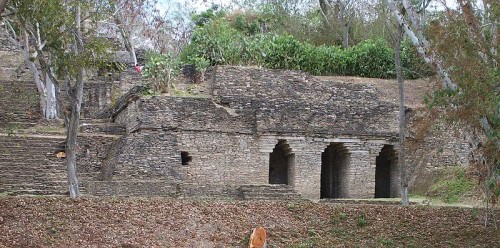
The Passages to the Underworld at Tonina
LABYRINTHS & THEIR MEANINGS
There have been many other labyrinths around the world since ancient times from the structure built in Italy as part of the tomb of the Etruscan king Lars Porsena (c. 580 BCE) to those of the island of Bolshoi Zayatsky (c. 500 BCE) in modern-day Russia. Celtic labyrinths are thought to have once been part of the mortuary rituals of Britain, Ireland, and Scotland and scholar Rodney Castleden notes:
Labyrinths constantly reappear in different forms at different stages in the evolution of Celtic culture and some of them are earlier than the Minoan labyrinths. The labyrinth as an idea is closely related to the knot: the line that winds all around a design. The difference is that, in a knotwork design, the line has no beginning and no end while, in a labyrinth, there is usually a starting point and a goal. Both symbolize journeys. This might be a particular journey or adventure or the overall journey of life itself. Labyrinths therefore form a visual counterpart to the epic folk-tale which often consists of a long and convoluted journey with episodes that repeat and double back on themselves. They may symbolize a journey of self-discovery too, a journey in to the center of the self and out again and, in this way, the ancient symbol emerges as a Jungian archetype: a tool for self-exploration and healing. (439-440)
This is certainly evident in the mandalas of Tantric literature from India and, most notably, in the Rigveda (c. 1500 BCE) in which the various books progress along the same lines as a labyrinth where one travels a spiritual path alone to eventually merge one's inner journey with the outer world. Carl Jung (1875-1961 CE) saw the labyrinth as a symbol of this reconciliation between the inner self and the external world. Scholar Mary Addenbrooke writes:
[Jung] describes the effect of being “gloriously, triumphantly drunk. There was no longer any inside or outside, no longer an 'I' and the 'others', No. 1 and No. 2 were no more (he is referring to his sense of having two dissimilar personalities within him); “caution and timidity were gone and the earth and sky, the universe and everything in it that creeps and flies, revolves, rises, or falls, had all become one.” (1)
Jung discusses the journey through the labyrinth in his Stages of Life :
When we must deal with problems, we instinctively resist trying the way that leads through obscurity and darkness. We wish to hear only of unequivocal results, and completely forget that these results can only be brought about when we have ventured into and emerged again from the darkness. But to penetrate the darkness we must summon all the powers of enlightenment that consciousness can offer... The serious problems in life are never fully solved. If ever they should appear to be so it is a sure sign that something has been lost. The meaning and purpose of a problem seem to lie not in its solution but in our working at it incessantly. This alone preserves us from stultification and petrifaction. (11)
The people of the ancient world seem to have understood this concept long before Jung articulated it so eloquently. The labyrinth, finally, is the journey of the self to wholeness. Although the ancient Egyptians or Greeks may not have phrased it this way, their architecture and myths point to the same conclusions Jung and other later psychologists have come to: that it is in working one's way through the labyrinth of one's present circumstances that one comes to realize one's purpose and a final meaning for existence.
Hammurabi › Who Was
Definition and Origins
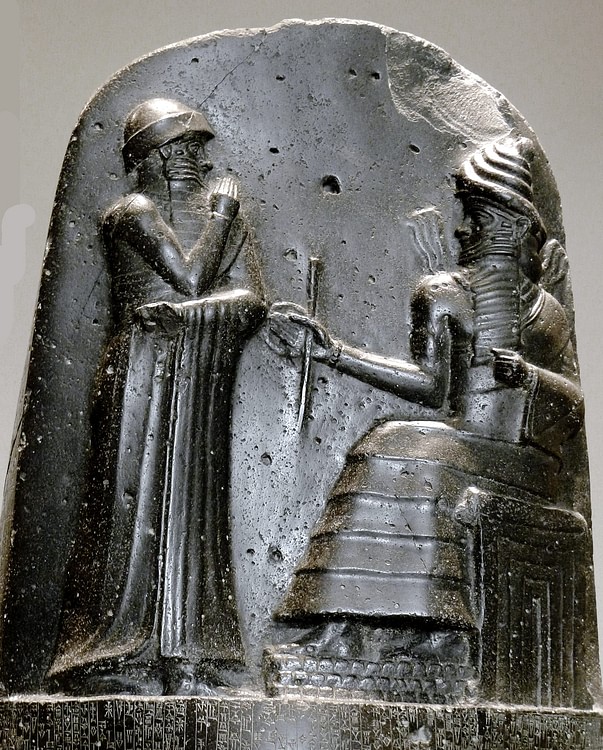
Hammurabi (also known as Khammurabi and Ammurapi, reigned 1792-1750 BCE) was the sixth king of the Amorite First Dynasty of Babylon, assumed the throne from his father, Sin-Muballit, and expanded the kingdom to conquer all of ancient Mesopotamia. The kingdom of Babylon comprised only the cities of Babylon, Kish, Sippar, and Borsippa when Hammurabi came to the throne but, through a succession of military campaigns, careful alliances made and broken when necessary, and political maneuvers, he held the entire region under Babylonian control by 1750 BCE and, according to his own inscriptions and letters and administrative documents from his reign, sought to improve the lives of those who lived under his rule. He is best known in the modern day for his law code which, although not the earliest code of laws, came to serve as a model for other cultures and is thought to have influenced the laws set down by Hebrew scribes, including those from the biblical Book of Exodus.
CONQUERED CITIES WERE ABSORBED INTO HAMMURABI'S KINGDOM & THEN REPAIRED & IMPROVED UPON.
BACKGROUND & RISE TO POWER
The Amorites were a nomadic people who migrated across Mesopotamia from the coastal region of Eber Nari (modern day Syria ) at some point prior to the 3rd millennium BCE and by 1984 BCE were ruling in Babylon. The fifth king of the dynasty, Sin-Muballit (reigned 1812-1793 BCE), successfully completed many public works projects but was unable to expand the kingdom or compete with the rival city of Larsa to the south. Larsa was the most lucrative trade center on the Persian Gulf and the profits from this trade enriched the city and encouraged expansion so that most of the cities of the south were under Larsa's control. Sin-Muballit led a force against Larsa but was defeated by their king Rim Sin I. At this point it is uncertain what exactly happened, but it seems that Sin-Muballit was compelled to abdicate in favor of his son Hammurabi. Whether Rim Sin I thought Hammurabi would be less of a threat to Larsa is also unknown but, if so, he would be proven wrong. The historian Durant writes:
At the outset of [Babylonian history] stands the powerful figure of Hammurabi, conqueror and lawgiver through a reign of forty-three years. Primeval seals and inscriptions transmit him to us partially – a youth full of fire and genius, a very whirlwind in battle, who crushes all rebels, cuts his enemies into pieces, marches over inaccessible mountains, and never loses an engagement. Under him the petty warring states of the lower valley were forced into unity and peace, and disciplined into order and security by an historic code of laws (219).
Initially, Hammurabi gave Rim Sin I no cause for alarm. He began his reign by centralizing and streamlining his administration, continuing his father's building programs and enlarging and heightening the walls of the city. He instituted his famous code of laws (c. 1772 BCE), paid careful attention to the needs of the people, improved irrigation of fields and maintenance of the infrastructures of the cities under his control, while also building opulent temples to the gods. At the same time he was setting his troops in order and planning his campaign for the southern region of Mesopotamia.
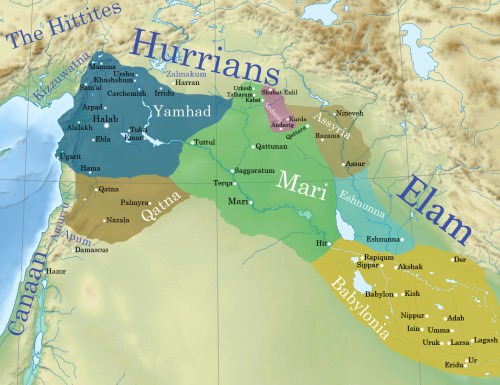
Ancient Syro-Mesopotamia ca. 1764 BCE
CONQUEROR OF MESOPOTAMIA
The historian Bertman notes how Hammurabi's personal character worked to his advantage early in his reign:
Hammurabi was an able administrator, an adroit diplomat, and canny imperialist, patient in the achievement of his goals. Upon taking the throne, he issued a proclamation forgiving people's debts and during the first five years of his reign further enhanced his popularity by piously renovating the sanctuaries of the gods, especially Marduk, Babylon's patron. Then, with his power at home secure and his military forces primed, he began a five-year series of campaigns against rival states to the south and east, expanding his territory (87).
When the Elamites invaded the central plains of Mesopotamia from the east, Hammurabi allied himself with Larsa to defeat them. That accomplished, he broke the alliance and swiftly took the cities of Uruk and Isin, previously held by Larsa, by forming alliances with other city-states such as Nippur and Lagash. The alliances he made with other states, would repeatedly be broken when the king found it necessary to do so but, as rulers continued to enter into pacts with Hammurabi, it does not seem to have occurred to any of them that he would do the same to them as he had previously to others. Once Uruk and Isin were conquered, he turned and took Nippur and Lagash, and then conquered Larsa. A technique he seems to have used first in this engagement would become his preferred method in others when circumstances allowed: the damming up of water sources to the city to withhold them from the enemy until surrender or, possibly, withholding the waters through a dam and then releasing them to flood the city before then mounting an attack. This was a method previously used by Hammurabi's father but with considerably less efficacy. Larsa was the last stronghold of Rim Sin and, with its fall, there was no other force to stand against the king of Babylon in the south.
HAMMURABI STRUCK SWIFTLY AT MARI IN 1761 BCE &, FOR SOME REASON, DESTROYED IT INSTEAD OF SIMPLY CONQUERING IT.
With the southern part of Mesopotamia under control, Hammurabi turned north and west. The Amorite Kingdom of Mari in Syria had long been an ally of Amorite Babylon, and Hammurabi continued friendly relations with the king Zimri-Lim (reigned 1755-1761 BCE). Zimri-Lim had led successful military campaigns through the north of Mesopotamia and, owing to the wealth generated from these victories, Mari had grown to be the envy of other cities with one of the largest and most opulent palaces in the region. Scholars have long debated why Hammurabi would break his alliance with Zimri-Lim but the reason seems fairly clear: Mari was an important, luxurious, and prosperous trade center on the Euphrates River and possessed great riches and, of course, water rights. Holding the city directly, instead of having to negotiate for resources, would be preferable to any ruler and certainly was so to Hammurabi. He struck swiftly at Mari in 1761 BCE and, for some reason, destroyed it instead of simply conquering it. This is a much greater mystery than why he would march against it in the first place. Other conquered cities were absorbed into the kingdom and then repaired and improved upon. Why Mari was such an exception to Hammurabi's rule is still debated by scholars, but the reason could be as simple as that Hammurabi wanted Babylon to be the greatest of the Mesopotamian cities and Mari was a definite rival for this honor. Zimri-Lim is thought to have been killed in this engagement, as he vanishes from the historical record in that same year. From Mari, Hammurabi marched on Ashur and took the region of Assyria and finally Eshnunna (also conquered by damming up of the waters) so that, by 1755 BCE, he ruled all of Mesopotamia.

Law Code Tablet of King Hammurabi from Nippur
HAMMURABI'S CODE & THE CARE OF THE PEOPLE
Although Hammurabi spent a considerable amount of time on campaign, he made sure to provide for the people whose lands he ruled over. A popular title applied to Hammurabi in his lifetime was bani matim, 'builder of the land', because of the many building projects and canals he ordered constructed throughout the region. Documents from the time attest to the efficacy of Hammurabi's rule and his sincere desire to improve the lives of the people of Mesopotamia. These letters and administrative works (such as directives for the building of canals, food distribution, beautification and building projects, and legal issues) support the view which Hammurabi held of himself. The prologue to his famous law code begins:
When the lofty Anu, King of the Annunaki and Bel, Lord of Heaven and Earth, he who determines the destiny of the land, committed the rule of all mankind to Marduk, when they pronounced the lofty name of Babylon, when they made it famous among the quarters of the world and in its midst established an everlasting kingdom whose foundations were firm as heaven and earth – at that time Anu and Bel called me, Hammurabi, the exalted prince, the worshipper of the gods, to cause justice to prevail in the land, to destroy the wicked and the evil, to prevent the strong from oppressing the weak, to enlighten the land and to further the welfare of the people. Hammurabi, the governor named by Bel, am I, who brought about plenty and abundance (Durant, 219).

Hammurabi's Law Code
His famous law code is not the first such code in history (though it is often called so) but is certainly the most famous from antiquity prior to the code set down in the biblical books. The Code of Ur-Nammu (c. 2100-2050 BCE), which originated with either Ur -Nammu or his son Shulgi of Ur, is the oldest code of laws in the world. Hammurabi's code differed from the earlier laws in significant ways. The historian Kriwaczek explains this, writing :
Hammurabi's laws reflect the shock of an unprecedented social environment: the multi-ethnic, multi-tribal Babylonian world. In earlier Sumerian-Akkadian times, all communities had felt themselves to be joint members of the same family, all equally servants under the eyes of the gods. In such circumstances disputes could be settled by recourse to a collectively accepted value system, where blood was thicker than water, and fair restitution more desirable than revenge. Now, however, when urban citizens commonly rubbed shoulders with nomads following a completely different way of life, when speakers of several west Semitic Amurru languages, as well as others, were thrown together with uncomprehending Akkadians, confrontation must all too easily have spilled over into conflict. Vendettas and blood feuds must often have threatened the cohesion of the empire(180).
The Code of Ur-Nammu certainly relies on the concept of “joint members of the same family” in that an underlying understanding by the people of proper behavior in society is assumed throughout. Everyone under the law was expected to already know what the gods required of them, and the king was expected simply to administer the god's will. As historian Karen Rhea Nemet-Najat writes,
The king was directly responsible for administering justice on behalf of the gods, who had established law and order in the universe. (221)

Cuneiform Tablet Listing the Names of Old Babylonian Kings
If a man put out the eye of another man, his eye shall be put out.If he break another man's bone, his bone shall be broken.If a man knock out the teeth of his equal, his teeth shall be knocked out.If a builder build a house for someone, and does not construct it properly,And the house which he built fall in and kill its owner, then that builder shall be put to death.If it kill the son of the owner of the house, the son of that builder shall be put to death.
Unlike the earlier Code of Ur-Nammu, which imposed fines or penalties of land, Hammurabi's code epitomized the principle known as Lex Talionis, the law of retributive justice, in which punishment corresponds directly to the crime, better known as the concept of 'an eye for an eye and a tooth for a tooth', made famous from the later law code of the Old Testament, exemplified in this passage from the Book of Exodus:
If people are fighting and hit a pregnant woman and she gives birth prematurely but there is no serious injury, the offender must be fined whatever the woman's husband demands and the court allows. But if there is serious injury, you are to take life for life, eye for eye, tooth for tooth, hand for hand, foot for foot, burn for burn, wound for wound, bruise for bruise (Exodus 21:22-25).
HAMMURABI'S LAW CODE SET THE STANDARD FOR FUTURE CODES IN DEALING STRICTLY WITH THE EVIDENCE OF THE CRIME & SETTING A SPECIFIC PUNISHMENT.
Hammurabi's law code thus set the standard for future codes in dealing strictly with the evidence of the crime and setting a specific punishment for that crime. What decided one's guilt or innocence, however, was the much older method of the Ordeal, in which an accused person was sentenced to perform a certain task (usually being thrown into a river or having to swim a certain distance across a river) and, if they succeeded, they were innocent and, if not, they were guilty. Hammurabi's code stipulates that:
If a man's wife has been pointed out because of another man, even though she has not been caught with him, for her husband's sake she must plunge into the divine river.
The woman who did so and survived the ordeal would be recognized as innocent, but then her accuser would be found guilty of false witness and punished by death. The ordeal was resorted to regularly in what were considered the most serious crimes, adultery and sorcery, because it was thought these two infractions were most likely to undermine social stability. Sorcery, to an ancient Mesopotamian, would not have exactly the same definition as it does in the modern day but would be along the lines of performing acts that went against the known will of the gods -- acts which reflected on oneself the kind of power and prestige only the gods could lay claim to. Tales of evil sorcerers and sorceresses are found throughout many periods of Mesopotamian history, and the writers of these tales always have them meet with a bad end as, it seems, they also did when submitted to the Ordeal.

King Hammurapi at Worship
HAMMURABI'S DEATH & LEGACY
By 1755 BCE, when he was the undisputed master of Mesopotamia, Hammurabi was old and sick. In the last years of his life his son, Samsu-Iluna, had already taken over the responsibilities of the throne and assumed full reign in 1749 BCE. The conquest of Eshnunna had removed a barrier to the east that had buffered the region against incursions by people such as the Hittites and Kassites. Once that barrier was gone, and news of the great king weakening spread, the eastern tribes prepared their armies to invade. Hammurabi died in 1750 BCE, and Samsu-Iluna was left to hold his father's realm against the invading forces while also keeping the various regions of Babylonia under control of the city of Babylon; it was a formidable task of which he was not capable.
THE VAST KINGDOM HAMMURABI HAD BUILT DURING HIS LIFETIME BEGAN TO FALL APART WITHIN A YEAR OF HIS DEATH
The vast kingdom Hammurabi had built during his lifetime began to fall apart within a year of his death, and those cities that had been part of vassal states secured their borders and announced their autonomy. None of Hammurabi's successors could put the kingdom back together again, and first the Hittites (in 1595 BCE), then the Kassites invaded. The Hittites sacked Babylon and the Kassites inhabited and re-named it. The Elamites, who had been so completely defeated by Hammurabi decades before, invaded and carried off the stele of Hammurabi's Law Code which was discovered at the Elamite city of Susain 1902 CE.
Hammurabi is best remembered today as a lawgiver whose code served as a standard for later laws but, in his time, he was known as the ruler who united Mesopotamia under a single governing body in the same way Sargon the Great of Akkad had done centuries before. He linked himself with great imperialists like Sargon the Great by proclaiming himself “the mighty king, king of Babylon, king of the Four Regions of the World, king of Sumer and Akkad, into whose power the god Bel has given over land and people, in whose hand he has placed the reins of government” and, just like Sargon (and others), claimed his legitimate rule was ordained by the will of the gods. Unlike Sargon the Great, however, whose multi-ethnic empire was continually torn by internecine strife, Hammurabi ruled over a kingdom whose people enjoyed relative peace following his conquest. The historian Gwendolyn Leick writes,
Hammurabi remains one of the great kings of Mesopotamia, an outstanding diplomat and negotiator who was patient enough to wait for the right time and then ruthless enough to achieve his aims without stretching his resources too far (83).
It is a testimony to his rule that, unlike Sargon of Akkad or his grandson Naram-Sin from earlier times, Hammurabi did not have to re-conquer cities and regions repeatedly but, having brought them under Babylonian rule, was, for the most part, interested in improving them and the standard of living of the inhabitants (a notable exception being Mari, of course). His legacy as a lawgiver reflects his genuine concern for social justice and the betterment of the lives of his people.
LICENSE:
Article based on information obtained from these sources:with permission from the Website Ancient History Encyclopedia
Content is available under License Creative Commons: Attribution-NonCommercial-ShareAlike 3.0 Unported. CC-BY-NC-SA License